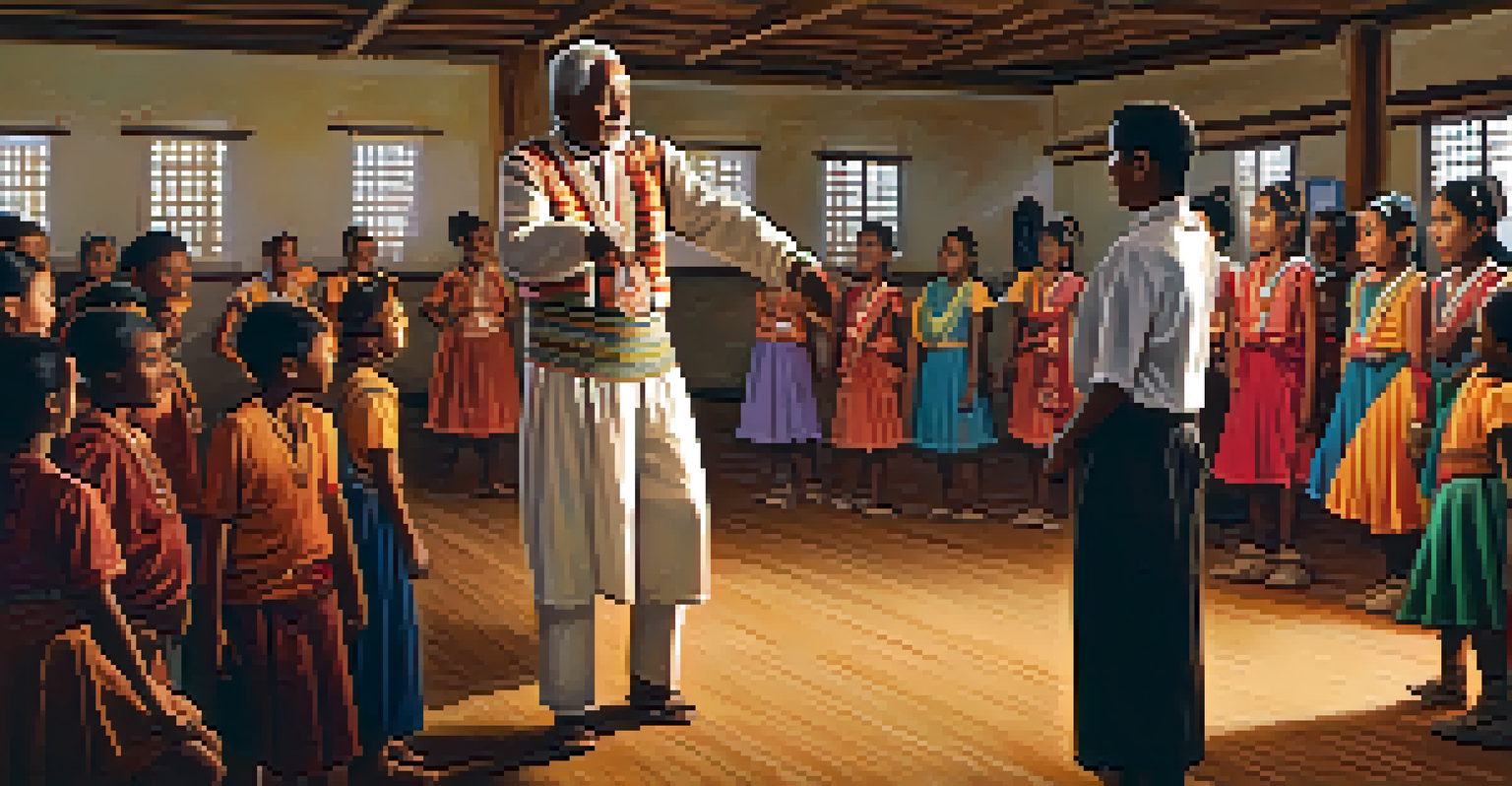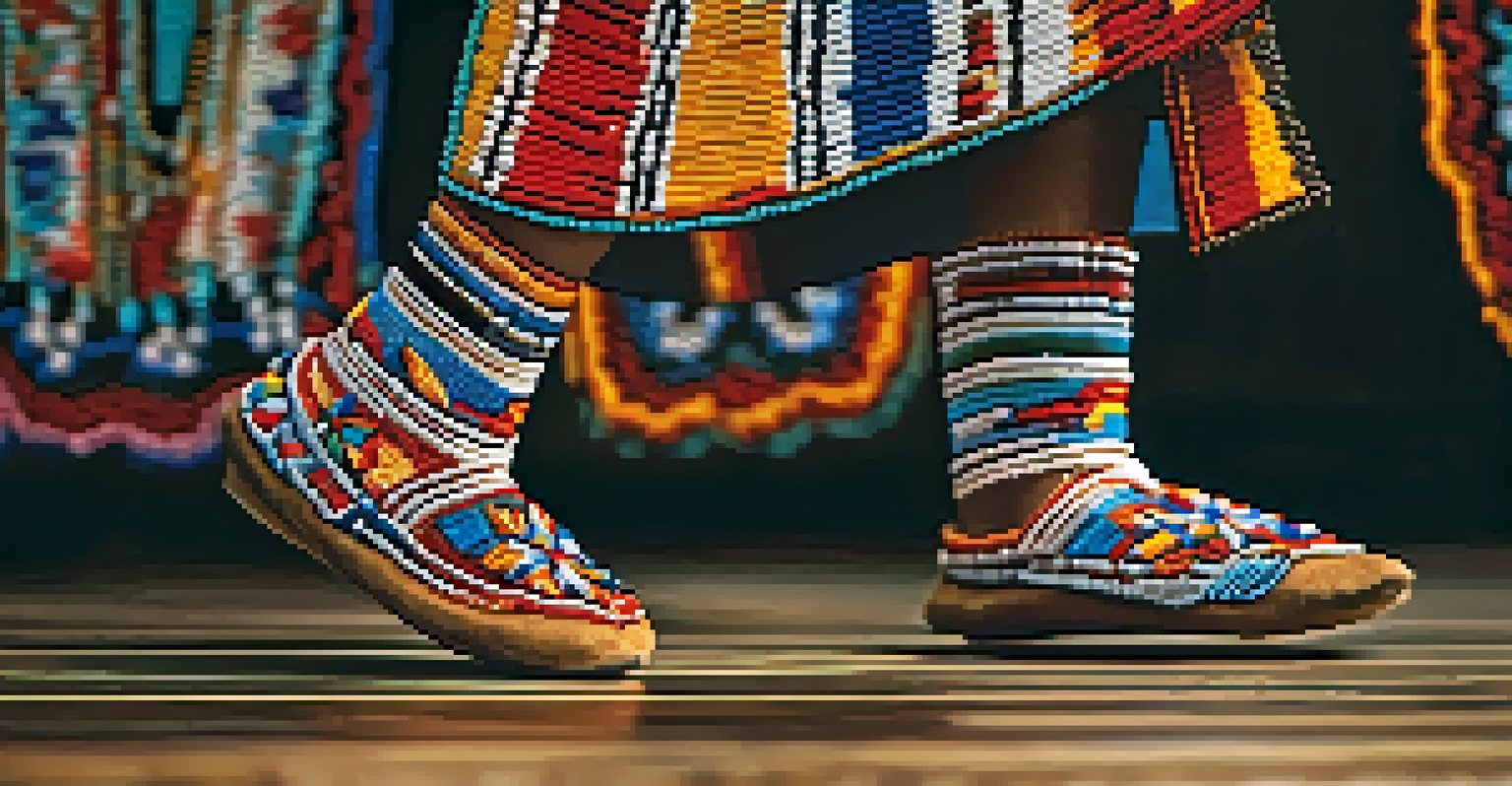Indigenous Dance: Preserving Culture and Advocating Change

The Rich Heritage of Indigenous Dance Forms
Indigenous dance is a vibrant expression of culture, deeply rooted in the histories and traditions of Native peoples. Each dance style carries its own unique significance, often telling stories of creation, survival, and spirituality. For instance, the powwow dances among various tribes serve as a communal celebration, uniting people through rhythm and movement.
Dance is the hidden language of the soul.
These dances are not just performances; they are living narratives that connect generations. They reflect the values, beliefs, and experiences of Indigenous communities, showcasing their resilience and adaptability. As participants don their traditional regalia, they honor their ancestors and the stories that have shaped their identities.
Moreover, the revival of these dances in contemporary settings highlights a commitment to cultural preservation. Many Indigenous artists are dedicated to teaching the youth about these practices, ensuring that the beautiful heritage of their communities continues to flourish.
Dance as a Tool for Cultural Preservation
Indigenous dance plays a crucial role in preserving cultural identity amid globalization. In a world that often prioritizes mainstream culture, these dances serve as a reminder of the unique traditions and histories that exist. They create a sense of belonging and pride among community members, reinforcing their cultural ties.

Workshops, festivals, and community gatherings present opportunities for the younger generation to learn and engage with these traditions. By participating in dance, individuals not only learn the steps but also the stories, languages, and values embedded within. This hands-on experience fosters a deeper appreciation for their heritage.
Cultural Heritage Through Dance
Indigenous dance serves as a vibrant expression of culture, connecting generations and preserving unique traditions.
Additionally, dance performances often attract attention from outside communities, creating a space for dialogue and understanding. This exchange not only educates others about Indigenous cultures but also empowers the dancers to share their narratives on a broader platform.
Advocacy Through Movement: A Call for Change
Indigenous dance has evolved to become a powerful form of advocacy, addressing contemporary social issues. Dancers often incorporate themes of environmental protection, social justice, and cultural rights into their performances, drawing attention to the struggles faced by Indigenous communities. This blend of art and activism resonates with audiences, sparking conversations about change.
Culture is the widening of the mind and of the spirit.
For example, performances that highlight the impact of climate change on Indigenous lands serve as a poignant reminder of the urgent need for environmental stewardship. Through captivating choreography and storytelling, dancers can illustrate the deep connection between their cultures and the land, ultimately inspiring action.
Moreover, these performances provide a platform for Indigenous voices to be heard. By sharing their experiences and challenges through dance, Indigenous artists advocate for their rights and raise awareness about the importance of preserving their cultures and environments.
The Role of Technology in Modern Indigenous Dance
In today's digital age, technology plays a significant role in the evolution of Indigenous dance. Social media platforms allow dancers to share their performances with a global audience, showcasing their cultures far beyond their local communities. This increased visibility helps to educate and inspire people from diverse backgrounds.
Virtual workshops and online classes have also emerged, creating opportunities for learning and connection. These platforms allow Indigenous dance instructors to reach students around the world, bridging gaps and fostering understanding. The ability to share knowledge digitally ensures that these cultural practices can thrive even in challenging times.
Advocacy and Awareness in Movement
Dancers use their art to address social issues, advocating for environmental protection and cultural rights.
However, while technology offers new avenues for promotion and preservation, it is essential to approach it with respect. Maintaining the integrity of Indigenous cultures in the digital realm is crucial, ensuring that traditions are represented authentically and ethically.
Intergenerational Knowledge Transfer in Dance
One of the beautiful aspects of Indigenous dance is its ability to foster intergenerational connections. Elders often play a pivotal role in teaching younger generations the significance of each movement and song, creating a rich tapestry of shared knowledge. This mentorship reinforces cultural values and practices, ensuring continuity.
Through this process, younger dancers gain not only technical skills but also a deeper understanding of their cultural heritage. They learn the stories behind the dances, the meanings of the songs, and the importance of their ancestors' teachings. This connection to the past enriches their identity and strengthens community bonds.
As these relationships form, they create a sense of responsibility among the youth to carry forward these traditions. By participating in dance, they become ambassadors of their culture, committed to preserving it for future generations.
The Impact of Indigenous Dance on Mental Health
Participating in Indigenous dance can have profound effects on mental health and well-being. Movement, rhythm, and expression allow individuals to release emotions and connect with their inner selves. For many, these dances serve as a form of therapy, providing a safe space to process feelings and experiences.
Moreover, the communal aspect of dance fosters a sense of belonging and support. Engaging with others who share similar cultural backgrounds creates bonds that can alleviate feelings of isolation and loneliness. This collective experience not only nurtures mental health but also reinforces community solidarity.
Technology's Role in Dance Evolution
Modern technology facilitates the sharing and teaching of Indigenous dance, allowing for global connections and cultural preservation.
Additionally, the spiritual connections made through dance can lead to greater self-awareness and empowerment. As dancers embrace their identities and heritage, they often experience a boost in self-esteem and confidence, leading to positive impacts in other areas of their lives.
Looking Ahead: The Future of Indigenous Dance
The future of Indigenous dance is bright, with a growing recognition of its importance in cultural preservation and advocacy. As younger generations continue to engage with these traditions, they are finding innovative ways to blend traditional practices with contemporary art forms. This fusion not only keeps the dance alive but also makes it relevant in today's society.
Furthermore, collaborations between Indigenous and non-Indigenous artists are becoming more common, creating opportunities for cross-cultural exchange. These partnerships can lead to new artistic expressions that honor Indigenous traditions while promoting social justice and awareness.

Ultimately, as long as there are passionate dancers and storytellers, Indigenous dance will remain a vital force in preserving culture and advocating for change. The movement will continue to inspire, educate, and unite people, ensuring that the rich heritage of Indigenous communities thrives for generations to come.